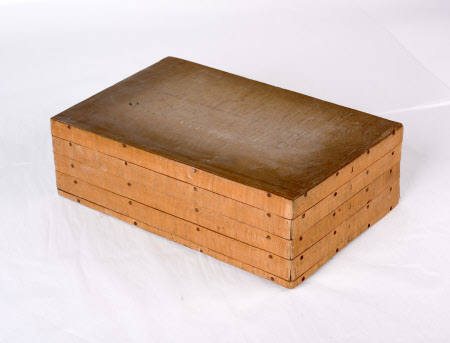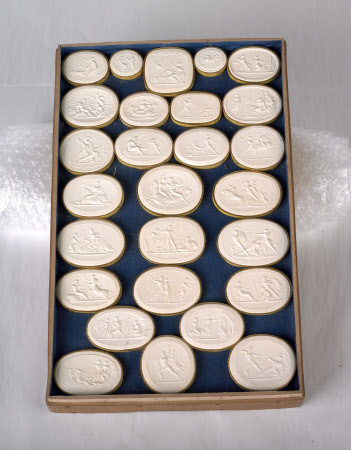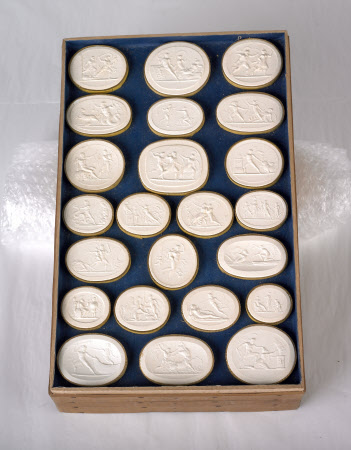A set of plaster casts of modern Roman gems and medals
Antonio Odelli (Rome, 1785- Rome, 1872)
Category
Art / Sculpture
Date
c. 1854 - 1856
Materials
Plaster, Wood
Place of origin
Rome
Order this imageCollection
The Argory, County Armagh
NT 565572
Summary
Sculpture, plaster; set of plaster casts of modern gems; Antonio Odelli (1785-1872); Rome, c. 1854-56. A large set of plaster casts of modern gems, some after designs by Antonio Canova (1757-1822), Bertel Thorvaldsen (1770-1844) and John Gibson (1790-1866), in trays which fit together to form a wooden box. In the eighteenth and nineteenth centuries, ancient Roman and Greek gems became extremely popular, with a number of workshops in Rome supplying casts of both ancient and more modern gems to collectors and to tourists, usually in the form of sets. One of two sets of casts of modern gems at the Argory sold by Antonio Odelli, one of the leading gem engravers at this time.
Full description
A set of plaster casts of modern gems, made by Antonio Odelli (1785-1872). The casts are in white plaster, with paper frames edged in gold, and are carefully arranged and stuck onto blue paper backgrounds, across four trays, which fit into each other to form a stacked rectangular box. They are protected by a detachable plain wooden lid, which has Antonio Odelli’s printed label on the inside. The first three trays contain respectively 23, 25 and 27 casts of so-called ‘Poniatowski gems’, modern gems in the antique style, whilst the fourth has 19 casts of gems reproducing works by modern sculptors including Antonio Canova (1757-1822), Bertel Thorvaldsen (1770-1844) and John Gibson (1790-1866), as well as a cast of a portrait medal of Thorvaldsen, by Bonfiglio Zaccagnini (1793-1867). There is a second series of Odelli casts at the Argory (NT 565575), consisting of a single tray, with casts of processional friezes based on the Parthenon sculptures, after the miniature copies designed by John Henning the Elder (1770-1851). The two boxes of casts are typical examples of the sets of casts of gems that were made in large numbers in Roman workshops, and offered for sale to libraries and museums as well as collectors and tourists visiting Rome (see Wilton and Bignamini 1996, no. 262, for a cabinet of casts of gems from the collection of Cristian Dehn (1696-1770)). Casts were often sold with descriptions of the individual gems, often hand-written. Antonio Odelli was a Roman gem engraver who worked closely over many years with the celebrated Castellani dynasty of Roman goldsmiths. His name appears regularly in the archives of the Castellani and indeed he seems to have enjoyed an especially close relationship with the much younger Augusto Castellani (1829-1914), who wrote in 1878 of his friend’s mastery of the art of gem cutting. This had already been recognised in 1862, when Odelli was awarded a prize at the International Exhibition in London, for a large cameo depicting the Hours leading the Chariot of the Sun (Pirzio Biroli Stefanelli 2006, pp. 107-08, fig.1). Odelli seems to have been well known to visitors to Rome for casts of intaglio and cameo gems, which were often sold in collections, such as the two sets at the Argory. As well as the two sets at the Argory, other plaster series by Odelli survive in the Archeological Institute in Göttingen, Germany, acquired in 1839-40 (Invs. A 893, A 890; Kockel and Graepler 2006, pp. 45-46, fig. 6; pp. 185-88, nos. 16-17), and in the Walters Art Museum in Baltimore. Whilst one of the sets in Göttingen seems to be a fairly conventional set of 75 casts after antique gems, the other consists of casts of Assyrian and Persian gems and seals. Between c. 1813-30 Odelli’s premises were at no. 143, Via Felice and then, between 1830 and 1856, in the Via delle Quattro Fontane. In around 1856 he moved again, to 143 Via Rasella. It may therefore be assumed from the labels on the box lids that the two sets of gem casts at the Argory were bought from Odelli’s shop on the Via delle Quattro Fontane and at some point between 1830 and 1856; however, the presence of a cast after John Gibson’s relief of Cupid and Pysche, the first marble version of which was made in 1854, would further suggest that the sets were in fact made around the mid 1850s, although Odelli's master casts of Poniatowski gems must have been made much earlier, before they were sent to sale in London in 1839. The first and more extensive set consists of three trays containing 55 casts after so-called Poniatowski gems, a major assemblage of Neo-classical designs (Wagner 2007; Boardman and Wagner 2022, pp. 43-45). The Poniatowski collection, which numbered around 2,500 gems, was formed by Prince Stanislas Poniatowski (1754-1833). In commissioning the gems from various gem-engravers in Rome, Poniatowski seems to have encouraged the gem cutters to use for their sources not the ancient sculptures to be seen in Rome and elsewhere, but rather Classical literature, especially the works of Homer, Virgil and Ovid. Many of Poniatowski’s gems were inscribed with the ‘signatures’ of famous ancient gem engravers. It is not in fact known whether Poniatowski was essentially duped or whether he was personally behind a gigantic attempt at fraud. He published a summary catalogue of his gems in 1830, with more elaborate descriptions following in two versions in 1833, both catalogues claiming the gems to be ancient. It was after the entire collection was sold at Christie’s in 1839 that it was recognised that they were in fact all modern. The fourth and final tray of the first set contains casts of gems copying works by the two most famous Neo-classical sculptors, Antonio Canova and Bertel Thorvaldsen, both of whom lived and worked in Rome for the greater part of their lives. Easily recognizable works include in the top two rows Canova’s Hercules and the Centaur (Kunsthistorisches Museum, Vienna) and Hercules and Lichas (Galleria d’Arte Moderna, Rome), whilst in the bottom row is a reduction of Thorvaldsen’s frieze ‘The Ages of Love’, made in 1824. Remarkably there is also a reduction of the British sculptor John Gibson’s frieze of ‘Cupid and Pysche’, the first version of which was made in 1854. The rarest and most significant cast in this tray is the portrait medal of Bertel Thorvaldsen, which is signed by the medallist Bonfiglio Zaccagnini (1793-1867). The inscription B. ZACCAGNINI F. IN CONCHIGLIA reads in English as “B. Zaccagnini made this in shell”, referring to a particular technique pioneered by Zaccagnini, who was a medallist but also carved shell cameos. In 1829 it was announced in the Notizie del Giorno (36, 1829, pp. 3-4) that Zaccagnini had discovered a method to plane down shells in convex form, so as to be able to make medals and medallions from them. Among his first works using this technique was a series of reductions of Thorvaldsen’s reliefs of the Elements; a set of plaster casts of Zaccagnini’s reductions are in the Harvard University Art Museums (Invs. 1929.336.47-50, 52). In 1830 he published a set of works by Thorvaldsen, reproduced in shell (Diario di Roma, 1, 1830, p. 48), whilst his medal of Thorvaldsen was published in 1846 (Diario di Roma, 17 October 1846, p. 4). There is another plaster cast of the medal, the shell version of which is not known to survive, in the Thorvaldsen Museum in Copenhagen (Inv. G142). Jeremy Warren November 2022
Provenance
Probably acquired by Walter McGeough Bond (1790-1866); by descent; Walter McGeough Bond (1908-86), by whom given to the National Trust in 1979.
Makers and roles
Antonio Odelli (Rome, 1785- Rome, 1872), maker after Bertel Thorvaldsen (Gronnegade 1770 – Copenhagen 1844), sculptor after Bonfiglio Zaccagnini (1793-1867), sculptor after John Gibson RA (Conway 1790 – Rome 1866) , sculptor after Antonio Canova (Possagno 1757 - Venice 1822), sculptor
References
Kockel and Graepler 2006: Valentin Kockel and Daniel Graepler, eds., Daktyliotheken. Götter und Caesaren aus der Schublade. Antike Gemmen in Abdrucksammlungen des 18. und 19. Jahrhunderts, Munich 2006 Pirzio Biroli Stefanelli 2006: Lucia Pirzio Biroli Stefanelli, Antonio Odelli: un incisore di cammei e intagli per gli orafi Castellani’, Bollettino dei Musei Comunali di Roma, New Series 20 (2006), pp. 107-118 Wagner 2008: Claudia Wagner, ‘A picture-book of antiquity. The neoclassical gem collection of Prince Poniatowski’, in M.J.Castillo Pascual et al., eds.,"Imagines". La Antigüedad en las Artes escénicas y visuales, Logroño 2008, pp. 565-72. Boardman and Wagner 2022 : John Boardman and Claudia Wagner, ‘The Wellington Gems – A Collection Dispersed’ in B. Chadour Sampson et al, eds., Liber Amicorum in Honour of Diana Scarisbrick. A Life in Jewels, London 2022, pp. 40-47




